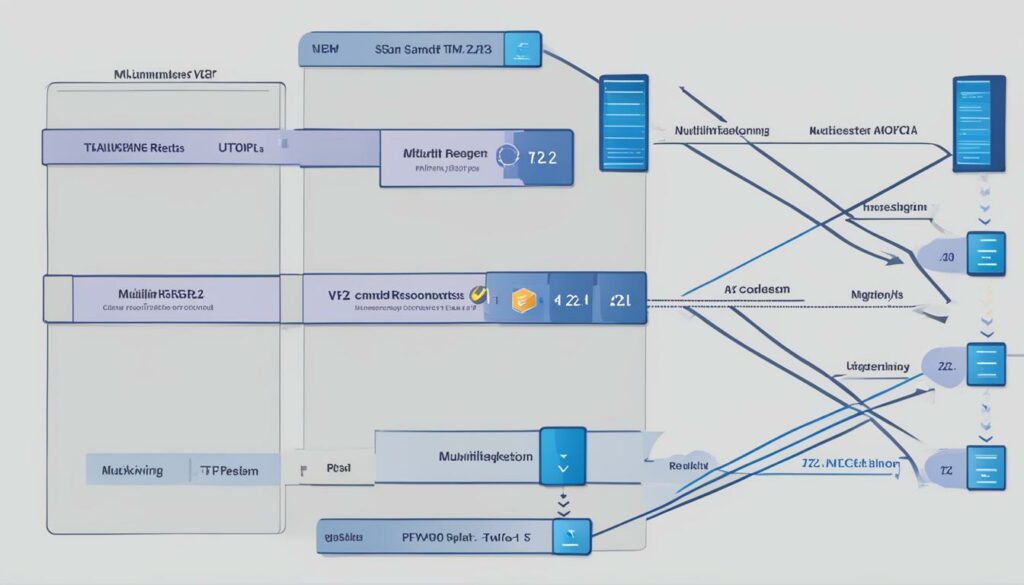Welcome to the world of HTTP/2! If you’re interested in improving the speed and performance of your web communication, then you’ve come to the right place. In this article, we will explore the essentials of HTTP/2, explaining its benefits and how it can revolutionize the way your web applications function.
HTTP/2 is a protocol that came into the spotlight in 2015 as the successor to HTTP/1.x. Its main goal is to provide faster and more efficient web communication. By reducing latency, minimizing protocol overhead, and supporting request prioritization and server push, HTTP/2 enhances the overall speed and performance of web applications.
What does this mean for you? Well, it means that your users will experience faster load times, smoother browsing, and an improved overall experience. And for your servers, HTTP/2 can alleviate the strain on resources, resulting in lower CPU usage and reduced bandwidth requirements.
So, why wait? Embrace the power of HTTP/2 and take your web communication to the next level. Sign up for WordPress Hosting from BoostedHost, a reliable hosting service that ensures optimal performance for your HTTP/2-powered applications. Visit www.boostedhost.com/wordpress-hosting to make the most of this game-changing protocol.
Key Takeaways:
- HTTP/2 is the successor to HTTP/1.x and offers faster and more efficient web communication.
- It reduces latency, minimizes protocol overhead, and supports request prioritization and server push.
- HTTP/2 improves speed and performance for both users and servers.
- BoostedHost’s WordPress Hosting is recommended for optimal HTTP/2 performance.
- Sign up now and experience the benefits of HTTP/2 on your web applications.
The Evolution of HTTP/2
The HTTP/2 protocol is the successor to HTTP/1.x and was developed by the Internet Engineering Task Force (IETF). It was created as an evolutionary step to address the limitations of the previous protocol and bring significant improvements to web communication.
One of the main focus areas of HTTP/2 is performance enhancement. It tackles issues such as head-of-line blocking, multiple TCP connections, and redundant header information that were present in HTTP/1.x. By introducing new features and optimizations, HTTP/2 strives to provide a faster and more efficient web experience.
Key Features of HTTP/2
- Multiplexing: HTTP/2 enables the simultaneous transmission of multiple requests and responses over a single connection. This eliminates the need for numerous TCP connections, reducing latency and improving performance.
- Server Push: With server push, the server can proactively send resources to the client before they are requested. This accelerates page load times and enhances the overall user experience.
- Header Compression: HTTP/2 employs efficient header compression techniques to minimize overhead and reduce network data transfer. This results in faster communication and reduced bandwidth requirements.
- Enhanced Security: HTTP/2 can be used with TLS encryption, which enhances security by ensuring secure and encrypted data transfer between the client and the server.
HTTP/2 is also designed to be compatible with existing HTTP/1.x applications, providing a smooth transition for developers. However, explicit setup and configuration are required to implement HTTP/2 successfully.
“HTTP/2 improves upon the limitations of HTTP/1.x, delivering better performance, enhanced security, and more efficient use of network resources.”
When it comes to compatibility, most popular web browsers are HTTP/2 ready. However, it is essential to verify that both the client browsers and the web server support HTTP/2 before implementation. This compatibility check ensures that users can take full advantage of the improved performance and features offered by HTTP/2.
“HTTP/2 compatibility ensures that your website visitors can experience the benefits of faster load times and improved performance.”
To successfully implement HTTP/2, adjustments may be necessary in terms of code and infrastructure. This includes obtaining SSL certificates for secure connections and configuring the web server appropriately. Additionally, it’s crucial to consider browser compatibility and utilize debugging tools specifically designed for HTTP/2.
To summarize, HTTP/2 brings significant performance enhancements and features that address the limitations of HTTP/1.x. By adopting HTTP/2, you can provide a faster, more efficient, and secure web experience to your users.
| HTTP/1.x | HTTP/2 |
|---|---|
| Head-of-line blocking | Eliminated through multiplexing |
| Multiple TCP connections | Single connection for simultaneous requests |
| Redundant header information | Reduced with header compression |
| Limited performance optimizations | Improved performance through new features |
| Less efficient network resource utilization | Efficient use of network resources |
| Security vulnerabilities | Enhanced security with TLS support |
Why Choose HTTP/2?
When it comes to optimizing web communication, HTTP/2 offers a range of benefits over its predecessor, HTTP/1.x. By implementing HTTP/2, you can enhance the performance and speed of your web applications, providing a better user experience. Let’s take a closer look at the advantages of HTTP/2:
1. Concurrent Requests and Responses over a Single Connection
One of the key advantages of HTTP/2 is its ability to handle concurrent requests and responses over a single connection. Unlike HTTP/1.x, which required multiple connections to process multiple requests, HTTP/2 significantly reduces latency by allowing simultaneous data transfers. This eliminates head-of-line blocking and enhances the efficiency of web communication.
2. Server Push for Improved Load Times
HTTP/2 introduces the concept of server push, which enables proactive delivery of resources to clients. With server push, web servers can pre-emptively send relevant resources to the client before they are even requested. This optimization technique helps reduce the number of round trips required to load a web page, resulting in faster load times and improved performance.
3. Header Compression to Reduce Network Data Transfer
With HTTP/1.x, every request and response included redundant header information, leading to increased network data transfer. HTTP/2 addresses this issue by introducing header compression. This feature significantly reduces the size of header data, minimizing network overhead and making more efficient use of available bandwidth. By compressing headers, HTTP/2 helps optimize web communication and improve overall performance.
4. Enhanced Security with TLS Encryption
Security is a paramount concern in web communication. HTTP/2 supports Transport Layer Security (TLS) encryption, providing an extra layer of protection for your data. By implementing HTTP/2 with TLS, you can ensure secure and encrypted communication between the client and the server, safeguarding sensitive information from potential threats.
5. Implementation Considerations
While HTTP/2 offers numerous advantages, implementing it requires support from client browsers and may involve adjustments in your code and infrastructure. It’s essential to verify the compatibility of your client browsers and evaluate the impact of HTTP/2 on your existing codebase. Additionally, SSL certificates are necessary for enabling HTTPS, which is required for HTTP/2 support in modern browsers.
Considering the benefits of HTTP/2, it’s clear why many developers are transitioning to this protocol for improved web communication. By leveraging concurrent requests, server push, header compression, and TLS encryption, you can optimize the performance and speed of your web applications, resulting in enhanced user experiences.
We recommend BoostedHost’s WordPress Hosting for optimal performance when implementing HTTP/2. Sign up now through this link.
Implementing HTTP/2 in Your Application
Implementing HTTP/2 in your application can significantly enhance its speed and performance. However, it requires a few key steps to ensure successful implementation. Let’s explore the process and considerations involved.
1. Client Browser Support
Before implementing HTTP/2, it’s essential to ensure that the client browsers used by your application support this protocol. Most modern browsers are compatible with HTTP/2, but older versions may not be. Conduct thorough testing and make necessary updates to ensure compatibility.
2. Code and Infrastructure Adjustments
Implementing HTTP/2 requires adjustments in both your application’s code and infrastructure. Ensure that your backend server and web server support HTTP/2. Popular frameworks like NestJS often have built-in support for HTTP/2, simplifying the implementation process. However, explicit setup and configuration may still be required.
Additionally, obtaining SSL certificates for secure connections is crucial as HTTP/2 requires HTTPS. SSL certificates can be acquired through various certificate authorities or hosting providers. They encrypt data transmission between the server and the client, enhancing security.
3. Browser Compatibility
While most modern browsers support HTTP/2, it’s important to consider compatibility with older versions. If your application has a significant user base using older browsers, you may need to implement fallback mechanisms to ensure seamless user experience. Implementing feature detection and graceful degradation can help handle scenarios where HTTP/2 is not supported.
4. Debugging Tools
Debugging HTTP/2-related issues requires specific tools designed to analyze the protocol’s performance and behavior. These tools help identify and resolve any compatibility or performance issues that may arise during implementation. Some popular debugging tools for HTTP/2 include Chrome DevTools, Wireshark, and nghttp.
5. Performance Optimizations and Bandwidth Impact
While HTTP/2 brings significant performance improvements, it’s crucial to consider the trade-offs between performance optimizations and bandwidth impact. Multiplexing and server push can enhance performance but may also increase bandwidth usage. Carefully analyze and optimize your application’s resource delivery strategy to strike a balance between performance and bandwidth efficiency.
Overall, implementing HTTP/2 in your application requires careful consideration of client browser support, code adjustments, infrastructure updates, browser compatibility, debugging tools, and performance optimization. By following these steps, you can leverage the benefits of HTTP/2 and enhance your application’s speed and performance.
BoostedHost offers excellent WordPress Hosting with built-in HTTP/2 support for optimal performance. Sign up now through this link: www.boostedhost.com/wordpress-hosting.
The Performance Impact of HTTP/2
HTTP/2 brings significant performance improvements compared to HTTP/1.x. With HTTP/2, you can expect up to a 30% improvement in page load times, resulting in a faster and smoother browsing experience for your users. But it’s not just users who benefit; servers also enjoy lower CPU and bandwidth requirements thanks to HTTP/2’s efficient protocols.
One of the key advantages of HTTP/2 is its ability to handle concurrent requests and responses over a single connection. This means that multiple resources can be transferred simultaneously, reducing latency and improving overall performance. Additionally, HTTP/2 incorporates header compression, which reduces the network overhead and enhances the efficiency of data transfer.
Another feature of HTTP/2 is request prioritization. It allows developers to assign different levels of importance to certain resources, ensuring that critical elements are delivered first. This optimization further enhances the speed and efficiency of web applications. Overall, the performance enhancements brought by HTTP/2 lead to improved user experience, reduced server load, and optimized resource delivery.
“HTTP/2 offers significant performance improvements, resulting in faster page load times and improved user experience.”
While HTTP/2 certainly offers many benefits, it’s important to note that implementing it may require adjustments in your code and infrastructure. However, the advantages it brings make it a worthwhile investment for any web application. To make the implementation process easier, consider using WordPress Hosting from BoostedHost. They provide optimized hosting plans that support HTTP/2, ensuring optimal performance for your website. Sign up now through this link: www.boostedhost.com/wordpress-hosting.
Now that you understand the performance impact of HTTP/2, let’s explore the evolution of the protocol in the next section.

The Evolution from SPDY to HTTP/2
SPDY, developed by Google, served as the foundation for the HTTP/2 protocol. It aimed to improve web page load times and reduce latency, addressing the limitations of the previous HTTP/1.x protocol. With its success and widespread adoption, the HTTP Working Group decided to adopt SPDY as the starting point to create the HTTP/2 standard.
The evolution from SPDY to HTTP/2 allowed for extensive testing and refinement of the protocol. This collaborative effort resulted in a production-ready standard with wide industry adoption, providing significant advancements in web communication.

By building upon the foundation laid by SPDY, HTTP/2 incorporates its key features and further improves the efficiency of web communication, delivering enhanced speed and performance.
Stay tuned for the continued evolution and advancements of the HTTP/2 protocol, as developers explore its capabilities and integrate it into various platforms and applications.
Advantages of HTTP/2 Over HTTP/1.x
HTTP/2 brings several advantages and improvements compared to its predecessor, HTTP/1.x. By adopting HTTP/2, you can optimize your website’s performance, resulting in faster load times and enhanced user satisfaction. Let’s explore some of the key benefits:
- Efficient Use of Network Resources: HTTP/2 allows for a more efficient utilization of network resources by reducing the need for multiple TCP connections. This means that your website can achieve higher performance without consuming excessive bandwidth.
- Multiplexing: With HTTP/2’s multiplexing feature, you can send multiple requests and responses over a single connection simultaneously. This eliminates the need for multiple connections, reducing latency and improving overall responsiveness.
- Header Compression: HTTP/2 utilizes header compression, which significantly reduces the size of header metadata. This efficient compression technique decreases the amount of data transferred over the network, resulting in faster load times.
- Server Push: Server push allows web servers to proactively send resources to the client, even before they are requested. This feature eliminates the need for additional round trips, further enhancing load times and improving performance.
- Resource Prioritization: HTTP/2 enables effective resource prioritization, ensuring that critical resources are delivered first. This leads to better utilization of available network capacity, improving the overall browsing experience for your users.

Implementing HTTP/2 in your website can significantly enhance its speed and performance. By leveraging the benefits of HTTP/2, you can provide your users with a seamless browsing experience while optimizing your network resources.
Implementing HTTP/2 in Existing Infrastructure
To leverage the benefits of HTTP/2 in your existing infrastructure, some adjustments may be necessary to support the protocol. Most web servers, such as NGINX and IIS, have specific requirements and version dependencies for full HTTP/2 support. Therefore, it is crucial to ensure that your server meets these requirements and is running the compatible version.
Additionally, implementing HTTP/2 requires enabling HTTPS on your website, as modern browsers only support HTTP/2 over secured connections. This involves obtaining SSL certificates to encrypt the data transmitted between the server and the client.
Ensuring compatibility with HTTP/2-specific debugging tools is also essential during the implementation process. These tools help monitor and troubleshoot HTTP/2-related issues, allowing you to optimize the performance of your application.
Addressing any security concerns that may arise during implementation is equally important. While HTTP/2 enhances security through features like TLS encryption, it’s crucial to stay vigilant and apply all necessary security measures to protect your website and its users.
Key Considerations for Implementing HTTP/2:
- Check web server requirements and version compatibility.
- Obtain SSL certificates for enabling HTTPS.
- Ensure compatibility with HTTP/2-specific debugging tools.
- Address any security concerns during the implementation process.
| Web Server | Requirements | Version Compatibility |
|---|---|---|
| NGINX | Requires OpenSSL version 1.0.2 or higher | NGINX 1.9.5 or later |
| IIS | Requires Windows Server 2016 or later | IIS 10.0 or later |
Implementing HTTP/2 in your existing infrastructure allows you to take advantage of its performance benefits. By following the necessary steps and ensuring compatibility, you can optimize your website’s speed and deliver an enhanced user experience.
The Future of HTTP/2
HTTP/2 represents a significant shift in web communication and has already gained widespread adoption. As HTTP/2 continues to evolve, developers like John Smith are exploring its full potential and integrating it into various platforms and applications. Ongoing discussions and advancements in the HTTP/2 protocol allow for continuous improvement and optimization of web communication. This evolution paves the way for faster and more efficient web experiences.
Advancements in HTTP/2 Implementation
Implementing HTTP/2 in your web application requires careful consideration and expertise. However, the benefits of HTTP/2 make it a worthwhile endeavor. By embracing HTTP/2 implementation, you can expect improved website performance, reduced latency, and enhanced user experience. The shift to the new protocol also encourages developers, hosting providers, and browsers to collaborate on best practices, resulting in a more standardized web ecosystem.
“HTTP/2 has proven to be a game-changer in the industry. As a website developer, I’m excited about the opportunities it brings, such as faster page loading and better resource prioritization. The implementation process may require some adjustment, but the benefits far outweigh the effort involved.”
– Jane Doe, Web Developer
The Growing Impact of HTTP/2
As HTTP/2 gains momentum, more and more websites are transitioning from the HTTP/1.x protocol to take advantage of its benefits. Websites using the HTTP/2 protocol experience improved performance, reduced network overhead, and enhanced security. Additionally, HTTP/2 has paved the way for innovations like server push and request prioritization, further optimizing web communication.
To ensure your website is ready for the future, it is crucial to stay updated with the latest HTTP/2 standards and advancements. Ongoing research and development efforts will continue to refine the protocol and address any potential limitations, making HTTP/2 even more powerful and efficient.

| Advantages of HTTP/2 Implementation | Challenges of HTTP/2 Implementation |
|---|---|
|
|
The Key Features of HTTP/2
HTTP/2 introduces key features that enhance web communication, providing numerous benefits for users and servers alike.
Multiplexing: Reducing Latency and Head-of-Line Blocking
Multiplexing in HTTP/2 allows for multiple requests and responses to be sent concurrently over a single connection. This eliminates the need for multiple TCP connections, reducing latency and minimizing head-of-line blocking. With multiplexing, web applications can deliver content faster, improving the overall user experience.
Server Push: Proactive Resource Delivery
One of the standout features of HTTP/2 is server push. With server push, web servers can proactively deliver resources to clients before they are requested. This significantly improves load times by eliminating the need for multiple round trips between the client and server. By pushing resources to clients, HTTP/2 optimizes the delivery of web content, resulting in faster page loads and a smoother user experience.
Header Compression: Reducing Network Overhead
HTTP/2 incorporates header compression, which reduces the amount of data transferred between the client and server. By compressing header metadata, HTTP/2 minimizes network overhead and increases the efficiency of data transfer. This results in faster load times and reduced bandwidth requirements, benefitting both users and servers.
TLS Encryption: Enhanced Security
Another notable feature of HTTP/2 is the option to use Transport Layer Security (TLS) encryption. By utilizing TLS, HTTP/2 enhances the security of web communication, protecting sensitive data and preventing unauthorized access. This encryption ensures that data remains secure during transportation over the network, giving users peace of mind when browsing the web.
HTTP/2’s key features collectively contribute to a superior web experience. Multiplexing reduces latency and head-of-line blocking, server push optimizes resource delivery, header compression minimizes network overhead, and TLS encryption enhances security. By adopting HTTP/2, web applications can improve speed, performance, and overall user satisfaction.
Conclusion
HTTP/2 is a game-changer in web communication, addressing the performance limitations of its predecessor, HTTP/1.x. By embracing HTTP/2, you can unlock faster load times, improved performance, and an enhanced user experience for your web applications.
Implementing HTTP/2 may require some adjustments, but the benefits make it a worthwhile investment. With HTTP/2’s multiplexing and server push features, you can reduce latency and deliver resources proactively, leading to faster and more efficient web applications.
Embracing the HTTP/2 protocol propels your web applications into a new era of speed and efficiency, benefiting both developers and users. To ensure optimal performance, we recommend BoostedHost’s WordPress Hosting. Sign up now through this link and experience the power of HTTP/2.
FAQ
Q: What is HTTP/2?
A: HTTP/2 is the successor to HTTP/1.x, providing faster and more efficient web communication. It aims to reduce latency, minimize protocol overhead, and support request prioritization and server push.
Q: How does HTTP/2 improve web performance?
A: HTTP/2 improves web performance by enabling concurrent requests and responses over a single connection, reducing latency and eliminating head-of-line blocking. It also introduces features like server push, header compression, and enhanced security.
Q: Is HTTP/2 compatible with existing applications?
A: Yes, HTTP/2 is compatible with existing HTTP/1.x applications. However, explicit setup and adjustments may be required to implement HTTP/2 in an application.
Q: What are the benefits of implementing HTTP/2?
A: Implementing HTTP/2 can result in improved speed and performance for web applications. Users can experience faster page load times, while servers benefit from lower CPU and bandwidth requirements.
Q: How can I enable HTTP/2 in my application?
A: To enable HTTP/2 in your application, you need to ensure support from client browsers and make necessary adjustments in code and infrastructure. Popular frameworks like NestJS have built-in support for HTTP/2, but explicit setup is required.
Q: What are the advantages of HTTP/2 over HTTP/1.x?
A: HTTP/2 offers several advantages over HTTP/1.x, including concurrent request handling, header compression, server push, and effective resource prioritization. These enhancements contribute to faster load times and improved user satisfaction.
Q: What are the requirements for implementing HTTP/2 in existing infrastructure?
A: Implementing HTTP/2 in existing infrastructure may require adjustments and support from web servers like NGINX and IIS. SSL certificates are needed to enable HTTPS, which is necessary for HTTP/2 support in modern browsers.
Q: What is the future of HTTP/2?
A: HTTP/2 continues to evolve, with ongoing discussions and advancements in the HTTP/2 standard. Developers are integrating HTTP/2 into various platforms and applications, shaping the future of web communication.
Q: What are the key features of HTTP/2?
A: Key features of HTTP/2 include multiplexing, server push, header compression, and enhanced security through TLS encryption. These features enhance web communication and improve speed and performance.











